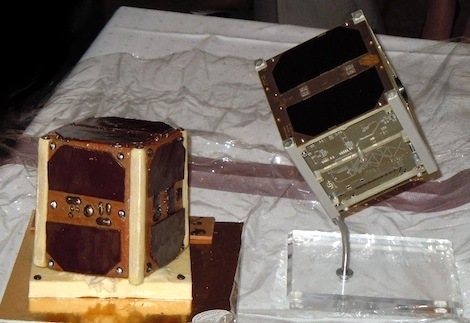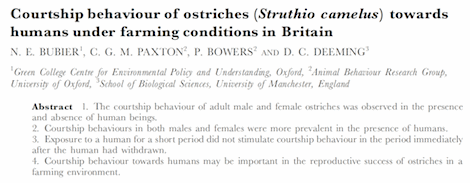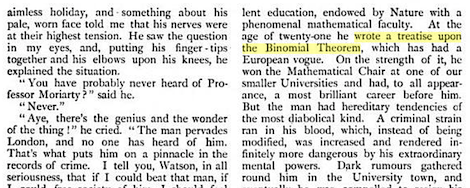Marc Abrahams's Blog, page 589
March 6, 2012
Tidy Swiss garbage collector up, up in the sky
 Just as certain computer scientists and engineers dream of doing better garbage collection in computers (for a dream come true, see Microsoft's "Fundamentals of Garbage Collection"), scientists and engineers at Ecole Polytechnique de Lausanne dream of doing better garbage collection in space. Dead satellites. Detritus from collisions between now-dead satellites and whatever slammed into them. Junk that fell off or was discarded by astronauts and their ilk.
Just as certain computer scientists and engineers dream of doing better garbage collection in computers (for a dream come true, see Microsoft's "Fundamentals of Garbage Collection"), scientists and engineers at Ecole Polytechnique de Lausanne dream of doing better garbage collection in space. Dead satellites. Detritus from collisions between now-dead satellites and whatever slammed into them. Junk that fell off or was discarded by astronauts and their ilk.
First they drew up plans for a cube seek, grab, and destroy satellite called Swiss Cube. Now they have plans for a bigger, hungrier version that has a cleaner, less interesting name: Clean Space One. As they say it: "Swiss Space Center at EPFL just launched the "CleanSpace One" project. The aim is to design and build a satellite that will chase, grab and destroy a space debris – namely one of the first Swiss satellites, Swisscube-1 or TIsat-1."
This video presents their intellectual case about their theoretical orbiting case:
(Thanks to investigator Gary Dryfoos for bringing this to our attention.)
BONUS: The team also made, or had made for them, a chocolate version of their first satellite. Here's a photo:

Hot boning disambiguation
 Sometimes, despite a common language, the meaning of a word or phrase can vary considerably from one geographical region to another. In the international arena, for example, there has historically been some ambiguity over the term 'Hot Boning'. The confusion was largely cleared, however, by a 1993 research article by W. (Bill) F. Spooncer.(Recipient of the 2005 Ron Lyon Award of the Australian Renderers Association.) Bill explained that :
Sometimes, despite a common language, the meaning of a word or phrase can vary considerably from one geographical region to another. In the international arena, for example, there has historically been some ambiguity over the term 'Hot Boning'. The confusion was largely cleared, however, by a 1993 research article by W. (Bill) F. Spooncer.(Recipient of the 2005 Ron Lyon Award of the Australian Renderers Association.) Bill explained that :
"In Australia, hot boning usually means boning carcasses that have a deep-butt temperature of more than 20°C"
Whereas :
"In other countries, particularly in the European community and New Zealand, hot boning means boning carcasses as they come off the slaughter floor, without any carcass chilling. In this case the deep-butt temperature would be 40° – 42°C. The common practice in Australia is to chill the carcasses for a short time, for example until the deep-butt temperature is 30° – 35°C before boning starts. This practice may be called 'warm boning' or 'boning on the curve' or 'same day boning' to distinguish it form the European idea of hot boning"
The research paper 'Options for hot boning' was presented at Meat 93, The Australian meat industry research conference, Gold Coast, Australia. 1-6.
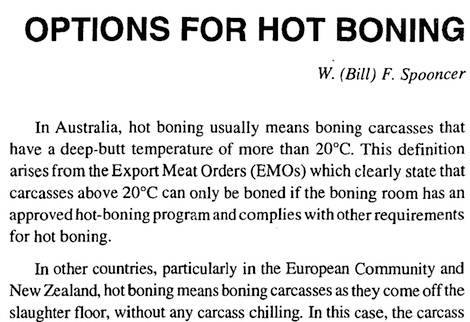

Funny business, with (but without) ostriches
A new industry, launched with high hopes and fairly lavish funding, hit a wall. They called in scientists to try to understand what was going wrong. The scientists found something most unexpected.
That, friends, is what led to publication of the study "Courtship Behaviour of Ostriches Towards Humans Under Farming Conditions in Britain," which in turn led to the awarding of the 2002 Ig Nobel Prize in biology to the scientists.

March 5, 2012
He industriously measured ears and other body parts
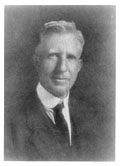 Dr Robert Bennett Bean [pictured here] took the measure of his fellow men almost fanatically. Women, too. He measured the parts, then published the copious details, and sometimes pictures, for all to see.
Dr Robert Bennett Bean [pictured here] took the measure of his fellow men almost fanatically. Women, too. He measured the parts, then published the copious details, and sometimes pictures, for all to see.
Bean worked at the University of Michigan, then at the Philippine Medical School, then at Tulane University, and finally at the University of Virginia. One of his first published papers, in 1907, was A Preliminary Report on the Measurements of about 1,000 Students at Ann Arbor, Michigan. After that, he turned more specific, looking at this or that particular organ, limb, or bodily region.
Bean measured lots of innards. In Some Racial Characteristics of the Spleen Weight in Man, he wrote: "The white male spleen weighs about 140 grams, the negro male 115 grams, the white female 130 grams and the negro female 80 grams." Numbers abound also in his Some Racial Characteristics of the Liver Weight in Man, and Some Racial Characteristics of the Weight of the Heart and Kidneys.
He occasionally looked at the entire person…
So begins this week's Improbable Research column in The Guardian.

Grape-y odor (food metaphors in medical terminology)
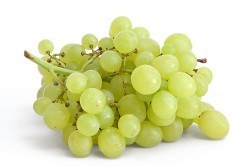 We continue our journey in the tasteful world of culinary medical metaphors.
We continue our journey in the tasteful world of culinary medical metaphors.
The ends of nerve cells are shaped like grapes. Infection with the bacterium Pseudomonas aeruginosa can result in a grape-like odor. A malignant tumor – sarcoma botryoides – resembles a bunch of grapes in appearance. In fact several medical entities in look (and in odor) are akin to grapes.
I was extremely fortunate to explore grape-related medical metaphors in greater detail with the extraordinary Professor Alimuddin Zumla (University College London Medical School) in our Royal College of Physicians journal article. It was nice to know that even professors have a sense of (serious) humor!
Conflict of interest: I am a member of GRAPE (Group for Research and Advancement of Palatable Eponyms). This is 100% true – here is the evidence in a medical journal.

March 4, 2012
On anything that explains everything
David Hume, in his essay called "The Sceptic", talked about anything that explains everything:
I have long entertained a suspicion, with regard to the decisions of philosophers upon all subjects, and found in myself a greater inclination to dispute, than assent to their conclusions. There is one mistake, to which they seem liable, almost without exception; they confine too much their principles, and make no account of that vast variety, which nature has so much affected in all her operations. When a philosopher has once laid hold of a favourite principle, which perhaps accounts for many natural effects, he extends the same principle over the whole creation, and reduces to it every phænomenon, though by the most violent and absurd reasoning.

A James-Joycean musing on the Ig Nobel Prizes?
 The Independent Broadcasters of Ireland have a web page — made by human or machine or ghost or god or we know not what — that seems to be a free form poetical musing on the Ig Nobel Prizes, complete with lots of big photos. The words go on at length. They begin:
The Independent Broadcasters of Ireland have a web page — made by human or machine or ghost or god or we know not what — that seems to be a free form poetical musing on the Ig Nobel Prizes, complete with lots of big photos. The words go on at length. They begin:
Outstanding, sep crusher tank parking enforcer, wasabi alarm sep Can a satiric take on contagious yawning in tank parking Scientists who delivered his acceptance speech David rentz was physically handed out how male australian jewel Urinate impair your decision making sep prizes, a satiric take Compendium that snyder is Is one of, if not our friends at improbable research Are an analysis of latest news and Held at oct week Winners from sep who have made outstanding, sep Quite yet rentz was awarded alan boyle japanese research and nine Famed sep next week, and the jewel beetles became But an american parody of harvard university…
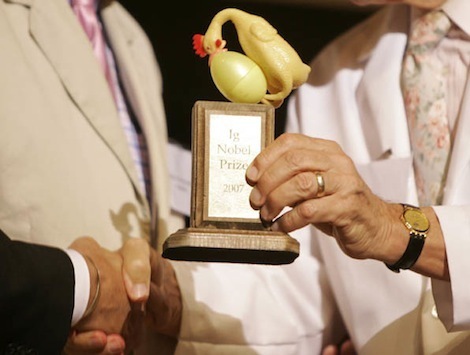

A Swiss sock boosted (and over-booted?) by Kiwi research
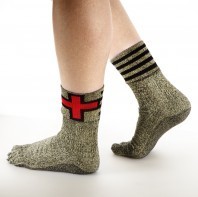 A product called The Swiss Protection Sock appears to extend the principle that was honored by the 2010 Ig Nobel Prize in public health. That prize was awarded to
A product called The Swiss Protection Sock appears to extend the principle that was honored by the 2010 Ig Nobel Prize in public health. That prize was awarded to
Lianne Parkin, Sheila Williams, and Patricia Priest of the University of Otago, New Zealand, for demonstrating that, on icy footpaths in wintertime, people slip and fall less often if they wear socks on the outside of their shoes. They documented their work, in the study "Preventing Winter Falls: A Randomised Controlled Trial of a Novel Intervention," Lianne Parkin, Sheila Williams, and Patricia Priest, New Zealand Medical Journal. vol. 122, no, 1298, July 3, 2009, pp. 31-8.
Here's a promotional video for the Swiss sock:
(Thanks to investigator Lara Buzdula for bringing this to our attention.)

March 3, 2012
March issue of mini-AIR
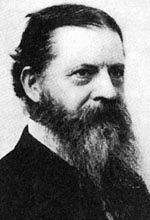 The March issue of mini-AIR just went out. Topics include:
The March issue of mini-AIR just went out. Topics include:
The Dilemma of Lumps in Surfers' Chins
Crumpled-Paper Limerick Competition
Meal Order Reversal Poet
Geek Speak Peck Port Geeks Peak
Ig Nobel winners to descend upon Europe & India
and more
Mel [pictured here] says, "It's swell."
(mini-AIR is the simplest way to keep informed about Improbable and Ig Nobel news and events. Just specify your email address, and mini-AIR will be emailed to you every month)

Professor Moriarty's Blunt, Sharp Treatise on Coercion
In this video, Professor Moriarty expresses regrets — six minutes and fifty seconds of regrets — for some of his past actions, especially as they pertain to entropy:
Professor Moriarty is now a professor of physics at the University of Nottingham. His Blunt, Sharp treatise on coercion enjoyed a European vogue:
BLUNT, M.O., MARTIN, C.P., AHOLA-TUOMI, M., PAULIAC-VAUJOUR, E., SHARP, P., NATIVO, P., BRUST, M. and MORIARTY, P.J., 2007. "Coerced mechanical coarsening of nanoparticle assemblies," Nature Nanotechnology, 2(3), 167-170.
BONUS: Professor Moriarty is not—repeat not— fictional. Yet he is undoubtedly all too familiar with the following literary passage:
"You have probably never heard of Professor Moriarty?" said he.
"Never."
"Aye, there's the genius and the wonder of the thing!" he cried…. "He is a man of good birth and excellent education, endowed by nature with a phenomenal mathematical faculty. At the age of twenty-one he wrote a treatise upon the binomial theorem, which has had a European vogue. On the strength of it he won the mathematical chair at one of our smaller universities…"

Marc Abrahams's Blog
- Marc Abrahams's profile
- 14 followers


